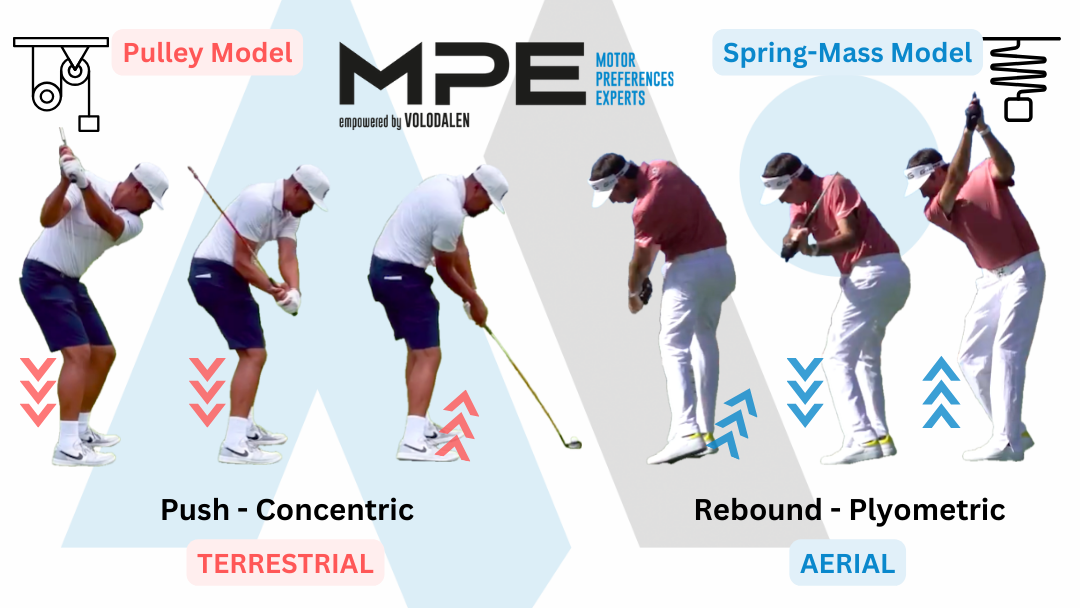Once you discern whether your golfer's inclination leans towards terrestrial or aerial, you can tailor your approach to suit their optimized system. At Motor Preferences Expert, drawing from scientific research conducted by Volodalen, we've identified two primary systems: the pulley system, favored by terrestrial golfers, and the spring-mass model, utilized by aerial golfers. Both approaches are equally effective and optimized to align with individual motor preferences.
It's important to understand that we operate within a spectrum, and each golfer uniquely navigates these optimized systems. While we aim to avoid rigid categorization, establishing a point on the spectrum provides a starting reference for the golfer's orientation. For example, recognizing your laterality in the frontal plane and understanding which side of your body favors extension or flexion will influence how you navigate these systems. However, based on your natural motricity as terrestrial or aerial, you ultimately gravitate towards one of these two optimized models for ultimate performance.
The spring-mass model embodies dynamic movement and sends back energy in the opposite direction that you give your force to, akin to a spring. Golfers who align with this model often demonstrate a High-Low-High* sequence, marked by a lighter backswing, heightened extension of the back leg, and a subtle squat initiated by activating the shoulders first at the start of the downswing. This culminates in a powerful rebound at impact, driven by a significant vertical force. Maintaining strong knee flexion throughout the backswing and downswing is unlikely to optimize efficiency for these aerial golfers. Attempting to execute a proficient rebound in this position may pose challenges.
On the other hand, terrestrial golfers favor the pulley model. Anchoring themselves, they generate forward force with their center of mass, utilizing their core to manipulate and exert force against the ground, akin to a pulley system. Their swing pattern typically follows a Low-High* sequence, anchoring the hips and maintaining knee flexion during the backswing, remaining at a consistent level at the start of the downswing, and ascending post-impact. They favored more Horizontal force compared to the aerial in the spring-mass model.
As a reminder, we all experience horizontal, rotational, and vertical forces during the swing motion, but in unique ways tailored to our natural motor preferences.
These systems can also be conceptualized as one more elastic and plyometric (spring-mass model) and the other more concentric (pulley model). Understanding these distinctions allows motor preferences coaches to design training programs that will activate and strengthen the appropriate muscle groups to optimize movement, maximize performance, and reduce the risk of injuries.
As depicted on the main poster of this article, Tony Finau exemplifies the Low-High sequence, while Bubba Watson embodies the High-Low-High sequence. Below, we have another example featuring Tiger Woods and Jason Day, each uniquely representing the Spring-Mass and Pulley models. Despite variations in the swing sequence compared to Tony Finau and Bubba Watson, they both adhere to these systems at impact. Everything is interconnected and rooted in their motor preferences, ultimately aimed at generating optimal movement leading up to the critical moment of the impact zone.


*Once again, it's essential to recognize that those patterns may vary based on other motor preferences, which a motor preferences specialist should evaluate to find your personalized sequence. This is a game-changer.
In this article, we have the swings of Tony Finau, Bubba Watson, Tiger Woods, and Jason Day. It's important to note that while they haven't undergone formal testing, our analysis is based solely on observable factors gleaned from video footage.
